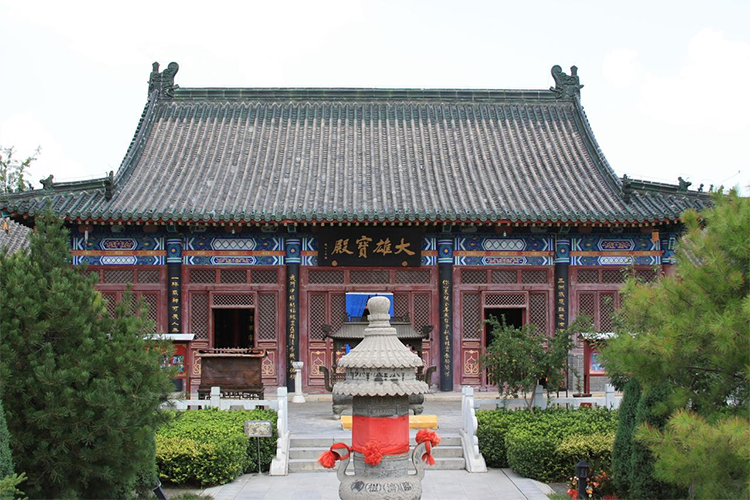Linji Temple: Birthplace of Zen Buddhism and a Cultural Bridge for Travelers
Introduction: Listening to a Thousand Years of Zen
Nestled in the quiet lanes of Zhengding County, Hebei province, Linji Temple (临济寺) stands as a millennium-old monastery and the birthplace of the Linji school of Chan (Zen). Famous for the Linji method of sudden shouts and strikes that jolt students into awakening, the temple also testifies to a long history of Sino-Japanese Buddhist exchange. Stroll among Tang-style halls and the soaring Jin-dynasty Chengling Pagoda—the stones themselves tell stories of Zen wisdom, architecture, and cultural continuity. For travelers seeking spiritual atmosphere, architectural art, and international Buddhist ties, Linji Temple is an exceptional destination.
1. Linji Temple’s Core Features and Spiritual Heart
One-line summary: “Ancestral seat of Linji Zen, known for sudden awakening techniques and a bridge between Chinese and Japanese Buddhism.”
Linji Temple’s primary appeal lies in being the birthplace of the Linji school, founded by the Tang monk Master Yixuan. The Linji pedagogical method—using abrupt shouts or a staff strike to break attachments and point directly to the mind—had profound influence and later transmitted to Japan, shaping major Japanese Zen lineages.
Architecturally, the temple blends Tang-style hall design with a Jin-dynasty multi-eaved brick pagoda, most notably the Chengling Pagoda. The pagoda and the restored Tang-style Mahavira Hall (Daxiong Baodian), funded by Japanese Linji practitioners in 1986, symbolize the temple’s role as a living link in Sino-Japanese Buddhist relations.
2. History and Cultural Status
(1) A thousand-year ancestral seat
Linji Temple was originally established in the second year of Xinghe during the Eastern Wei (540 AD), giving it nearly 1,500 years of history. During the Tang dynasty Master Yixuan resided here and founded the Linji school, one of the most influential branches among Chan’s Five Houses.
(2) Jin-dynasty architectural gem — Chengling Pagoda
The Chengling Pagoda standing in the temple compound dates to the Jin dynasty and reaches 30.47 meters. This densely eaved brick pagoda is exceptionally well preserved and is an important example for studying Jin-period Buddhist architecture: clean lines, ordered tiers, and subtly upturned eaves.
(3) Witness to Sino-Japanese Buddhist exchange
In 1986 Japanese Linji practitioners contributed funds to rebuild the Mahavira Hall in a Tang style, restoring the temple’s historic appearance. Today Linji Temple is both a nationally important temple and a recurring destination for Japanese monks and lay pilgrims, underscoring its ongoing role in cultural exchange.
3. Architecture and Art Highlights
(1) Tang-style Mahavira Hall
Reconstructed in 1986, the Mahavira Hall preserves classic Tang architectural elements—soaring eaves and intricate bracket systems—conveying a dignified, elegant presence. Inside, a statue of Shakyamuni Buddha is flanked by sculptures of the Eighteen Arhats, creating a solemn and contemplative atmosphere.
(2) Chengling Pagoda — a model of multi-eaved brick pagoda design
Chengling Pagoda is Linji Temple’s most historically valuable structure. With nine exterior tiers and gently upturned eave corners, it showcases the skill of Jin-era brick pagoda craftsmanship. The pagoda once housed Buddhist relics and remains a key object of architectural and religious study.
(3) Zen hall and practice spaces
The temple has a dedicated Zen hall for seated meditation, where resident monks train. Visitors can sense the Linji tradition’s direct method and may be able to participate in introductory meditation sessions to experience Zen’s calm and immediacy.

4. Religious Activities and Immersive Experiences
(1) Morning bell, evening drum, and meditation
– Each morning the temple performs a bell ritual whose resonant tone ushers in the day’s contemplative mood.
– Visitors may join guided zazen (sitting meditation) sessions to experience Linji practices that emphasize direct insight.
(2) Lamp offerings and blessings
– The temple offers lamp-lighting rituals where visitors can light a lamp and make a wish or prayer.
– On the Buddha’s Birthday (lunar April 8), Linji Temple holds a large-scale ceremony drawing many devotees and creating a solemn, communal atmosphere.
5. Setting and Atmosphere
Located inside Zhengding’s ancient city, Linji Temple sits among other historic structures and enjoys a peaceful environment. It is not an overwhelmingly crowded tourist site, making it ideal for visitors seeking tranquility. In autumn, the golden ginkgo leaves framing the Chengling Pagoda create especially photogenic scenes for photographers.
6. Suggested Visit Plan
– Recommended visit time: 1–2 hours (extend to half a day if participating in meditation).
– Best visiting times: early morning or late afternoon to avoid crowds and experience quiet temple life.
– Combine with other Zhengding sites: pair your visit with Longxing Temple and Kaiyuan Temple for a fuller ancient-city Buddhist tour.
7. Practical Tips
(1) Dress and etiquette
– Dress modestly when entering temple buildings (avoid short skirts or shorts).
– Keep voices low and show respect for monks and worshippers during rituals.
(2) Hours and tickets
– Opening hours: 8:00–17:00. Admission: free.
– Guided tours: arrange a guide or use an audio guide (English available in some services).
(3) Getting there
– Public transport: From Shijiazhuang city take a bus to Zhengding South Gate stop, then a 10-minute walk.
– By car: There is a parking area outside the temple; parking fees are approximately ¥10 per hour.

8. Local Insights
– Best photography spot: beneath the ginkgo trees in front of Chengling Pagoda; autumn’s golden foliage creates a deeply Zen tableau.
– Watch out for scams: avoid unlicensed fortune-tellers or overpriced “merit” services around the temple grounds.
Conclusion: Enduring Zen, the sound of the Linji shout
Linji Temple is more than an ancient monastery; it is an active repository of Chan wisdom. Whether you come for the austere Jin-dynasty Chengling Pagoda, the dignified Tang-style Mahavira Hall, or the living bonds between Chinese and Japanese Buddhism, Linji Temple rewards quiet attention. If you crave a soulful journey, step inside and listen for the echo of a thousand-year Linji shout.


